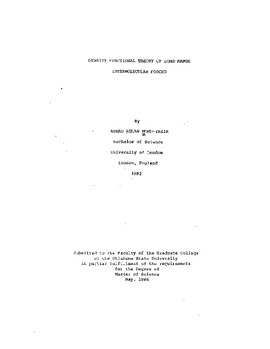| dc.contributor.advisor | Westhaus, Paul | |
| dc.contributor.author | Mohd-Yasir, Ahmad Azlan | |
| dc.date.accessioned | 2016-01-12T16:53:23Z | |
| dc.date.available | 2016-01-12T16:53:23Z | |
| dc.date.issued | 1986-05-01 | |
| dc.identifier.uri | https://hdl.handle.net/11244/24591 | |
| dc.description.abstract | The Ground-State Energy of a system of two neutral molecules was developed using the formalism of Density Functional Theory. This method of approach in deriving the Ground-State Energy bypasses the traditional quantum mechanical wave function method and was seen to be considerably simplified in its computational procedures. Using the formulation of Levy and Freed, the electron density, and then the Energy Functional, was obtained as a Taylor Series expansion about a reference density. Optimization of the density then led to the derivation of the Ground-State Energy whentthis optimum density was used as the density in the Energy Functional. | |
| dc.format | application/pdf | |
| dc.language | en_US | |
| dc.publisher | Oklahoma State University | |
| dc.rights | Copyright is held by the author who has granted the Oklahoma State University Library the non-exclusive right to share this material in its institutional repository. Contact Digital Library Services at lib-dls@okstate.edu or 405-744-9161 for the permission policy on the use, reproduction or distribution of this material. | |
| dc.title | Density Functional Theory of Long-range Intermolecular Forces | |
| dc.type | text | |
| dc.contributor.committeeMember | Dixon, George S. | |
| dc.contributor.committeeMember | Scott, H. L. | |
| osu.filename | Thesis-1986-M697d.pdf | |
| osu.accesstype | Open Access | |
| dc.description.department | Physics | |
| dc.type.genre | Thesis | |
